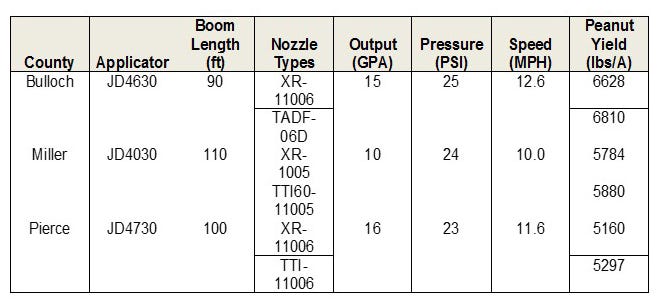December 4, 2018

It has been awhile since I penned an article for this column. I was uncomfortable with writing anything in the aftermath of Hurricane Michael. I wish all speedy recovery. Also, I have been dealing with the emotional and financial burdens of two of my children’s weddings (OUCH!). But the show must go on!
Frequently, one of the issues that I hear about the most from farmers in regard to research is the applicability of small-plot research versus large-plot research. Small-plot research is necessary for scientists to get a good and thorough look at new technologies long before they get into the hands of the grower. Large-plot research is used to compliment results from these small-plot trials as well as demonstrate effectiveness on a grander scale (i.e. the real world).
Over the past few years, I have been conducting a fair amount of small-plot research on the use of “auxin” nozzles for weed control in peanut. As a quick reminder, auxin nozzles are required for use with the Xtend cropping systems (dicamba on tolerant cotton and soybean). These nozzles produce coarser droplets designed to help reduce physical drift. Generally, my small-plot results in peanut have been acceptable, with auxin nozzles performing similarly to flat fan nozzles except for annual grass control (slightly lower with certain auxin nozzles).
Once a grower starts to use these auxin nozzles, it does not take long for him or her to figure out the vast differences between them and regular flat fan nozzles. Consequently, most cotton growers, who are also very likely to be peanut growers, have asked me if these auxin nozzles can be used in peanut to apply everything and I mean everything (herbicides, insecticides, fungicides, and fertilizers)! Historically, many pesticides used in peanut have required optimum coverage which usually occurs with finer, but more drift-prone, spray droplets.
In my first attempt to answer this complicated question using large-plots, I asked 3 different peanut growers and their county extension agents in Bulloch, Miller, and Pierce counties in 2018 to apply ALL of their agri-chemicals with their own spray equipment using a flat fan nozzle or an auxin nozzle. My colleagues and I then kept tabs on each field and were able to collect various types of pest control and yield data. By the way, replicated peanut yield data was collected on plots ranging in size from 0.414 to 0.735 acres, and can be seen in Table 1 with this article.
A quick summary of the applicators and peanut yield data from these tests is presented in Table 1. For the record, the TTI60 nozzle used in Miller Co. has not yet been approved for use in Xtend cropping systems but does produce ultra-coarse droplets (VMD50 >665 microns). Results from these large-plot tests suggest that there were no differences in weed, insect, or disease control between flat fan nozzles and the auxin nozzles with the exception of threecornered alfalfa hopper (3-CAH) in Miller Co. At that location, 3-CAH populations were higher in plots treated with the TTI60 nozzle. Additionally, no statistical differences in peanut yield were observed.
These large-plot results are very encouraging and support the findings of my earlier small-plot weed control research. However, I am in no way suggesting that every peanut grower should start using auxin nozzles in 2019. It is definitely true that auxin nozzles result in coarser spray droplets which are more likely to reach the target than move off-site, especially when the wind gets up. But, additional research needs to be conducted to ensure that the effectiveness of all agri-chemicals (herbicides, fertilizers, fungicides, and insecticides) will not be compromised when applied with coarser droplets.
As always good weed hunting!

About the Author(s)
You May Also Like






